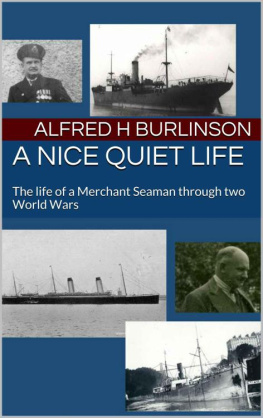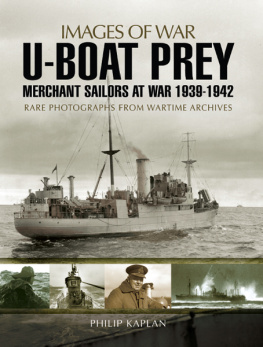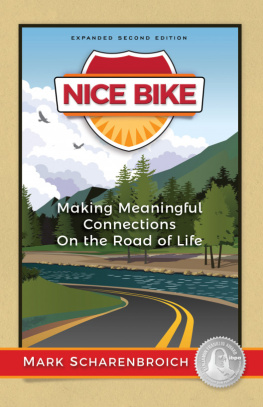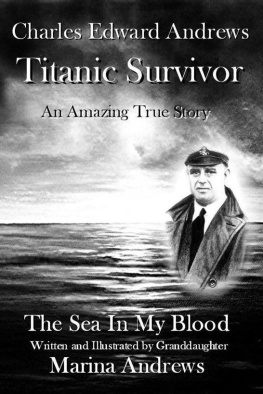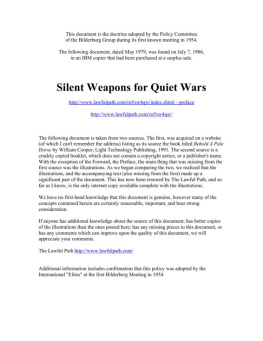Burlinson - A Nice Quiet Life: The life of a Merchant Seaman through two World Wars
Here you can read online Burlinson - A Nice Quiet Life: The life of a Merchant Seaman through two World Wars full text of the book (entire story) in english for free. Download pdf and epub, get meaning, cover and reviews about this ebook. year: 2014, genre: Non-fiction. Description of the work, (preface) as well as reviews are available. Best literature library LitArk.com created for fans of good reading and offers a wide selection of genres:
Romance novel
Science fiction
Adventure
Detective
Science
History
Home and family
Prose
Art
Politics
Computer
Non-fiction
Religion
Business
Children
Humor
Choose a favorite category and find really read worthwhile books. Enjoy immersion in the world of imagination, feel the emotions of the characters or learn something new for yourself, make an fascinating discovery.
- Book:A Nice Quiet Life: The life of a Merchant Seaman through two World Wars
- Author:
- Genre:
- Year:2014
- Rating:4 / 5
- Favourites:Add to favourites
- Your mark:
- 80
- 1
- 2
- 3
- 4
- 5
A Nice Quiet Life: The life of a Merchant Seaman through two World Wars: summary, description and annotation
We offer to read an annotation, description, summary or preface (depends on what the author of the book "A Nice Quiet Life: The life of a Merchant Seaman through two World Wars" wrote himself). If you haven't found the necessary information about the book — write in the comments, we will try to find it.
Burlinson: author's other books
Who wrote A Nice Quiet Life: The life of a Merchant Seaman through two World Wars? Find out the surname, the name of the author of the book and a list of all author's works by series.
A Nice Quiet Life: The life of a Merchant Seaman through two World Wars — read online for free the complete book (whole text) full work
Below is the text of the book, divided by pages. System saving the place of the last page read, allows you to conveniently read the book "A Nice Quiet Life: The life of a Merchant Seaman through two World Wars" online for free, without having to search again every time where you left off. Put a bookmark, and you can go to the page where you finished reading at any time.
Font size:
Interval:
Bookmark:

`A Nice Quiet Life
Introduction
Alfred was born in Sunderland on 15 th July 1884. He grew up living with his parents, and his younger brother William who was born three years later, in 1897. Their home was a modest terraced house in a fairly decent area of the town, and for his early education, he attended a Penny-a-Week School. Sunderland and Newcastle, at the time together formed the biggest ship building area in the world, and his father worked in the ship yards as a boiler inspector, checking the safety of boilers on the ships, and he was also a collector and dealer of machinery parts. We dont know much more about Alfreds childhood except this tale of a summer holiday.
When he was nine years old, he went by himself to visit his grandparents during his summer holidays. His grandfather John Learmond was head of the Customs in Cork, Ireland. Alfred was put on a train at Sunderland, under the care of the Guard, and transferred to the ferry to cross to Ireland, then took another train from Belfast to Cork. During this holiday he also travelled to Blarney Castle and kissed the famous Blarney Stone to give him good luck. He certainly had that.
After he left school, at the age of 14, he followed the family tradition and became an apprentice. He also became a choirboy in his local church, and later played the organ for the church services. Perhaps it was this experience that gave him a yearning to enter the church, because after completing his apprenticeship he left the world of engineering went on to a religious school - Kelham College, in Newark to study for the Priesthood.
His fellow students and the lecturers at the College thought he was a very serious young man and not able to lighten up, so one day the students, as a prank, rolled him up in a corridor mat, which ended up outside the Principals door. Alfred laughed so much the Principal came out of his office to see what was going on. He looked down at Alfred sternly, but then broke into a smile and said Well Burlinson, Im pleased to see you laughing at last. After that, he became accepted by the other students and life became more enjoyable, but the pressure of trying to master Greek and Latin was too much and sadly he was forced to give up this ambition. He returned to engineering, and using his apprenticeship qualifications he signed up with a merchant ship in 1908, as a junior engineer.
Here is his story
Alfred H Burlinson D.R RNR Ret
Newport Mon
During my apprenticeship in Engineering, discussions arose about what we lads wished to do when we were out of our apprenticeship. When I was asked what I wanted to do, I replied All I want is a nice quiet life
On persuasion from my family and friends I set forth how my wishes came true
A Nice Quiet Life
SS Alston
[Built by Priestman of Southwick, Sunderland and launched August 1903. 105.8 metres long, and 14.2m beam, with a top speed of 12 knots. Built for a small tramp ship company 'Webster & Barraclough', of West Hartleplepool.]
One Sunday morning in March 1908 I was in the choir of the parish church of St Hilda, Sunderland. The psalms for the day brought the words They go down to the sea in ships. I stopped singing for a moment, somewhat amazed because in my pocket was a telegraph telling me to join the SS Alston in Barry Dock at 8am next morning. I set off as soon as the service had finished, and after a very long train journey I got there on time. I started working as soon as I arrived and was very busy for those first few days helping to get the ship ready for sea. We set sail on the Wednesday bound for Colombo in Ceylon, with a cargo of coal; a long voyage which would take us round the Cape of Good Hope in South Africa. We sailed out in to the Atlantic where we ran into rough weather which gave me my first bout of seasickness. Youll soon get over it someone said to me, but it took me 22 years before I could stand up to bad weather without suffering seasickness.
When we approached the Equator the ship sailed through a violent storm, yet there was no wind, just stifling calm. I asked my chief what he thought about it. He told me that the Captain was of the opinion that an earthquake had taken place somewhere. When we arrived at Colombo I heard that Messina and many other towns had been destroyed by an earthquake. Later I checked up how far we had been from Co l o mbo when we had experienced the storm. It was nearly 3,000 miles, yet we had experienced waves 30ft high.
Three years later (1911) I passed through the Straits of Messina which is in the same area and saw that most towns had been so damaged that they had built new houses on the end of streets outside the old towns.
[Angus G. Elliott , of Alberta, Canada, whose father, it is believed, served aboard the ship in the 1919/1920 period, advises that from 1904 to 1913, the vessel travelled extensively, including to Suez, Rio de Janeiro & Buenos Aires in S. America & to New Orleans & Galveston in the U.S.
On Dec. 24, 1915, dynamite was found aboard the vessel, believed to be the result of an attempted German sabotage.]
While in Colombo I spent some Sunday afternoons ashore. On one of these, my Chief was trying to meet a native who had promised that he would take us over a Hindu Temple, but the man had gone away on a Passenger Steamer, so we spent the afternoon wandering around the native quarters learning how other folk live and earn a living. The local women used the forerunner of our modern washing machines, two flat stones, the larger one seems to have lain at the side of the dhobi pool for centuries and the women laid the laundry on the big stone and beat it with a smaller one. Curiously they managed to get a - Persil Whiteness without using the Persil.
One day one of the many merchants who sought a share of the few pounds, that were my monthly pay, was a man who put 8,000 worth of rubies, emeralds and other stones on our mess table. Unfortunately I did not have the money to buy any. However, one day later, I bought two garnets for about one shilling and six pence and they were given to a relative who had to pay fifteen shillings to get an additional matching stone to make a three stone ring.
We went on to Java to load sugar for New York. It seemed that every little port we went to, had a volcano near it; and as we neared Java itself, we passed near to Krakatau the famous volcano that had blown up in 1883. 35,000 folk had died in the explosion, and five towns disappeared under the sea.
We also noticed 5 palm trees growing on the beach and other signs of vegetation starting green patches: a very interesting bit of re-creation.
Java sugar was packed in bamboo baskets, each containing some 400 pounds. It was interesting to see it stowed, for when a row looked full, they managed with much singing to squash more in.
The north coast of Java is so shallow that ships lie five miles off shore, the cargo coming in 200 ton lighters.
The nights are rather eerie out there. The ships steel plates act like a mighty microphone and the weird noises sent me down in the engine room thinking there was something wrong. It seems the weird noises were a mixture of fishermens tonal lures and fishes chatting.
_______________________________________
[ The fishes chatting may be Pistol Shrimps. A contributor on a yachting discussion forum made this entry recently:
13-08-2012
Is the fizzing noise really some kind of shrimp?
Font size:
Interval:
Bookmark:
Similar books «A Nice Quiet Life: The life of a Merchant Seaman through two World Wars»
Look at similar books to A Nice Quiet Life: The life of a Merchant Seaman through two World Wars. We have selected literature similar in name and meaning in the hope of providing readers with more options to find new, interesting, not yet read works.
Discussion, reviews of the book A Nice Quiet Life: The life of a Merchant Seaman through two World Wars and just readers' own opinions. Leave your comments, write what you think about the work, its meaning or the main characters. Specify what exactly you liked and what you didn't like, and why you think so.

